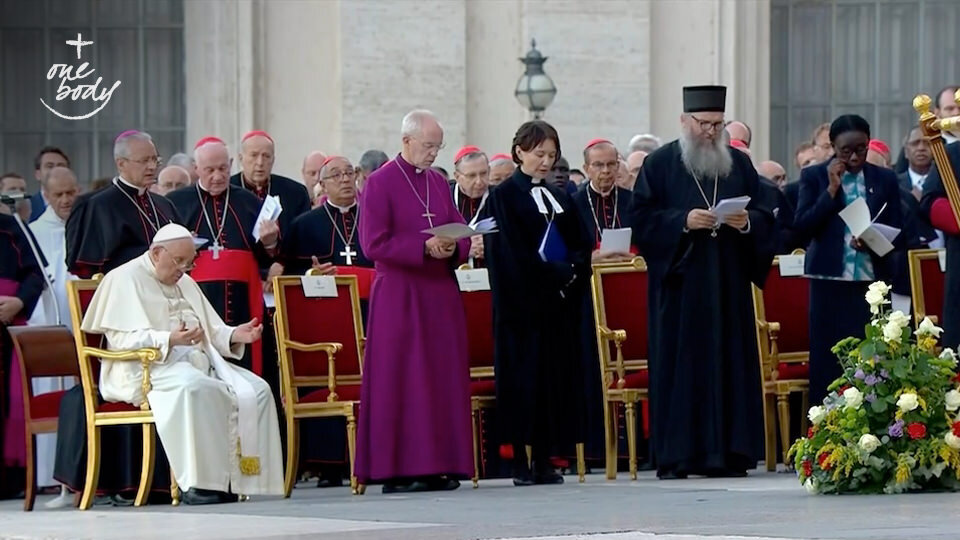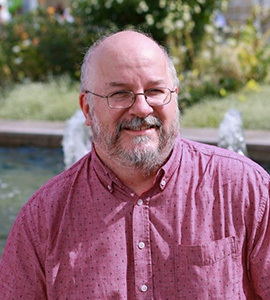

No Synodality Without Ecumenism | One Body
Nicholas Jesson
Thursday, October 5, 2023

Pope Francis and the leaders of various Christian communities recite the Our Father during the Ecumenical Prayer Vigil in St. Peter's Square on September 30, 2023.

No Synodality Without Ecumenism
by Nicholas Jesson
“There is no synodality without ecumenism and no ecumenism without synodality.” These words were spoken at the “Together: Gathering of the People of God” ecumenical service on Saturday, September 30, in St. Peter’s Square in Rome. When I heard these words from the podium, I took notice. Ecumenism and synodality are both reform movements in the church. The integral connection between the two seemed self-evident to me, but it’s a good reminder. It was a sunny Saturday afternoon and the square was filled with potted plants and trees as part of September’s Season of Creation observances. Leaders from major world churches were there, including Patriarch Bartholomew of Constantinople, Archbishop Justin Welby of Canterbury, Coptic Pope Tawadros II, Pastor Anne Burghardt of the Lutheran World Federation, and many others. The monks of Taizé, a Ukrainian children’s choir, and several other singers and musicians established a prayerful and meditative vigil. Pope Francis was the host and offered a homily on silence, stressing three values for Christians today: to hear God’s voice, to listen to the people of God, and to enter into prayer. We need “to free ourselves from so much noise in order to hear God’s voice. For only in our silence does his word resound.” Francis reminded us that it is only when we fall silent to listen to others that the Holy Spirit is able to "draw together points of view.” And finally, he concluded, silence “is fundamental to prayer, and ecumenism begins with prayer and is sterile without it.” The introductory remarks that caught my attention deserve to be quoted in full:There is no synodality without ecumenism and no ecumenism without synodality. Both are rooted in the baptismal dignity of the entire people of God. Together, they invite renewed commitment to the vision of a missionary synodal church. They are spiritual processes of repentance, forgiveness, and reconciliation in a dialogue of conversion that can lead us to a healing of memories.This concise statement contains several key points that are simple yet profound.
Rooted in baptism
As I explained in July’s post “The Universal Priesthood and Synodality” and in September 2021’s post “A Primer on Synodality,” the renewed understanding of the church, taught by Vatican II, begins with the whole people of God established in baptism and called together to be participants in Christ’s priestly, prophetic, and kingly ministry. As we have reiterated in many One Body posts, Christians are gathered by baptism into the one body of Christ – not just Catholics, but all Christians. So, whatever divisions have wounded the body, fundamentally, we are all one in Christ because we share a common baptism in Christ. Baptism is not just about a spiritual unity among believers; it is the source of the universal priesthood of all. In baptism, we are elevated beyond our merely human flesh to share in Christ’s incarnation, in which human nature participates in the communion of the three persons of the Trinity. Already created in the image and likeness of God, the baptized Christian now shares in the divine mission. As Christ is priest, prophet, and king, so too are all the baptized. Each of us is called to live out our life in the world so as to serve Christ’s mission to build the kingdom of God.A missionary synodal church
The whole people of God, constituted as such by baptism, is united in our shared mission. As churches sharing in this singular mission, we are called to work together, both because it is more practical and efficient, and because our divided witness impedes the mission to which we are called. There are many ways that the church has been conceived in Christian theology. Until the 20th century, it was commonplace for Catholic theology to begin with the four marks of the church from the Nicene Creed: "one, holy, catholic, and apostolic." The church has also been described as an institution, a perfect society structured by doctrine and laws. Others have described the church as the communion of saints, characterized by the formation of Christians for holiness and sanctification, embracing lives of sacrifice, piety, and purity. Fr. Avery Dulles, S.J. wrote the seminal work Models of the Church, where he unpacks the central ideas operating in post-Vatican II church life and theology. His insistence that the church encompasses each model, not just one or another, is key to using these models. An essential aspect of the post-Vatican II understanding of the church, however, is the dynamic character of the church. No longer conceived principally as a static institution, the church is sent out into the world as a pilgrim; the church is a herald, a proclamation of the good news, and a sacrament of the encounter with Christ. Frequently today, we encounter a new word, “missional,” to describe this missionary vitality in the church.Spiritual processes of repentance, forgiveness, and reconciliation
The past years have seen an increasing awareness in the Catholic Church, and all churches, of the need for collective truth-telling, examination of conscience, and restoration. The revelations of the experiences of clergy sexual abuse in all parts of the church have exposed endemic clericalism and its use to shelter the offenders and silence the victims. Similar experiences of trauma by Residential School survivors have begun a national and ecclesial examination of conscience about how colonialism has shaped contemporary Canadian society and the church's role in this history. The tragic treatment of Indigenous people in Canada is matched by similar experiences around the world, where the church has uncritically supported colonization and suppression of local and Indigenous culture, language, and spiritualities. Sexual abuse and colonialism are not the first processes of collective repentance that our church has undertaken. Beginning with Vatican II, the church has been confronting a dreadful history of anti-Semitism that we now acknowledge contributed profoundly to the social attitudes in which the Holocaust was possible. Beginning with the Council’s decree Nostra Aetate, the Catholic Church has been forthright in rooting out the historical teachings of deicide, blood libel, contempt for the Jews, supersessionism, and other aspects of this history. Pope Francis is not alone in making papal apologies. Pope John Paul II called the church to repentance as he offered over 100 apologies during his papacy, including those to Jews, women, people convicted by the Inquisition, and Muslims killed by the Crusaders. He apologized for the African slave trade, religious wars of the 16th century, the silence of many Catholics during the Holocaust, the execution of Jan Hus, and the sacking of Constantinople in 1204. In 2001, he apologized for clergy sexual abuse, the church’s participation in stealing children of Aboriginal Australians, and the colonialism of Christian missionaries in China. The synodal image of “walking together” is employed in each of these processes of reconciliation. There is no path to reconciliation that relies on church proclamations or unilateral declarations without the hard work of building relationships. Reconciliation involves truth-telling, repentance and contrition, accompaniment, and a sincere willingness to listen and respond to the prompting of those that we have wounded. So we “walk with” survivors of Residential Schools, with victims of sexual abuse, with ecumenical and interfaith partners, with refugees, and all in need of our care. Reconciliation is about healing wounded relationships.A dialogue of conversion
The synodal journey calls us to listen attentively to the voiceless, those marginalized or oppressed, and those wounded and in need of our care. This synodal journey takes a similar path to the ecumenical movement. For ecumenists, dialogue is a central method of encounter with other Christians. Dialogue requires listening to the partner and identifying elements of common life and faith. Historic experiences are examined to find new ways to understand the causes of our divisions, to set these disputed issues within a new context where they need not be a source of division, and to find new and life-giving ways to express shared truths. Ecumenists speak about a dialogue of truth, a dialogue of life, and a dialogue of charity. In the dialogue of truth, we seek to uncover consensus in the fundamental truths of our common faith. This may require that we learn to tell the story of our divisions in a new way, correct stereotypes and misunderstandings, and ensure that we no longer elevate minor matters. It is an exercise in truth-telling, just as we must repent for anti-Semitism, clergy sexual abuse, and colonization of Indigenous peoples. In parallel with our conscious and intentional work of truth-telling, we also have a dialogue of life with family, friends, and neighbours. As we share our joys and hopes, griefs and anxieties in our life together, we discover in one another the movement of the Spirit calling us to repentance, forgiveness, and reconciliation. The dialogue of charity occurs in our work of service, advocacy for justice, and witness of love for those in need. The values we promote and the principles we defend will speak more eloquently than anything we can articulate. As we work with our partners in shared service, we are engaged in a dialogue of charity that draws us closer to Christ and one another. Dialogue leads us to conversion, not only of the dialogue participants, but if it is authentic, conversion of the whole church. The Groupe des Dombes, a French Reformed-Catholic dialogue, has called our attention to this aspect of dialogue in their statement “For the Conversion of the Churches” (1993).A healing of memories
The final element mentioned in the introductory remarks is the healing of memories. It can be challenging to ask for forgiveness from those who have experienced trauma at the hands of the church. Forgiveness only comes with healing. To speak of a healing of memories is not to forget, to deny the past, or to pretend. However, memories of past divisions, conflicts, and offences can be transformed so that they no longer condemn the present parties but serve as salutary markers on a complicated journey into the present. An example of the ecumenical healing of memories has occurred in the Mennonite-Roman Catholic dialogue, resulting in the report “Called Together to be Peacemakers.” Mennonites experienced considerable persecution in the 16th century at the hands of Catholics. At the root of the conflict was the practice of believers’ baptism by Mennonites and other Anabaptists in what has been called the Radical Reformation. Unlike the Protestant Reformation, which was sparked by the doctrine of justification and other aspects of the doctrine of salvation, the Anabaptist decision to re-baptize adults who had received baptism as infants was interpreted as apostasy by church authorities. This resulted in penal sanctions, including execution by drowning, burning, and strangling. Today, believers’ baptism is commonly practiced by churches across a spectrum from Mennonite to Evangelical to Pentecostal, a group of Christian communities that seem foreign to Catholic understanding and experience. The dialogue with Mennonites has not resolved the question about the age for baptism; however, working together in public advocacy for justice and peace, our two communities have come to recognize one another as Christians. The 16th-century Mennonite experience of persecution inculcated a deeply rooted ethos of peace and non-violence. Though the Catholic Church is not a pacifist church, we find common cause with peace churches in advocacy for justice. In dialogue, we recognize our call to be peacemakers, which comes from our faith in Christ, the Lamb of God and Prince of Peace. Thus, the memory of our past treatment of Mennonites has begun to be healed as we see one another in new ways.Conclusion
“No synodality without ecumenism” is not likely to become a programmatic slogan of the church. However, it captures an important connection between these two great concerns for the church in the modern world. Each involves active listening to others and to the Holy Spirit. Each begins and proceeds in prayer. And, each results in a healing of memories and broken relationships. The synodal journey shares all of the elements of listening, dialogue, healing, and prayer that ecumenists have embraced. To be synodal, to be ecumenical, requires that we are attentive to the pilgrim journey of the church in all of its holy and human dimensions. It is a challenging task, but we walk this journey with Christ. There is a traditional Celtic blessing with which many churches end their Sunday services:May the Christ, who walks on wounded feet, walk with you on the road. May the Christ, who serves with wounded hands, stretch out your hands to serve. May the Christ, who loves with a wounded heart, open your hearts to love.
 Nicholas Jesson is both the Synod coordinator and the ecumenical officer for the Archdiocese of Regina. He is currently a member of the Anglican-Roman Catholic Dialogue in Canada and of the Canadian Council of Churches’ Commission on Faith & Witness, editor of the Margaret O’Gara Ecumenical Dialogues Collection, and editor of the Anglican-Roman Catholic Dialogue archive IARCCUM.org. He was ecumenical officer for the Diocese of Saskatoon (1994-99 & 2008-17), executive director of the Prairie Centre for Ecumenism (1994-99), and member of the Roman Catholic-United Church of Canada Dialogue (2012-20).
Nicholas Jesson is both the Synod coordinator and the ecumenical officer for the Archdiocese of Regina. He is currently a member of the Anglican-Roman Catholic Dialogue in Canada and of the Canadian Council of Churches’ Commission on Faith & Witness, editor of the Margaret O’Gara Ecumenical Dialogues Collection, and editor of the Anglican-Roman Catholic Dialogue archive IARCCUM.org. He was ecumenical officer for the Diocese of Saskatoon (1994-99 & 2008-17), executive director of the Prairie Centre for Ecumenism (1994-99), and member of the Roman Catholic-United Church of Canada Dialogue (2012-20).Related Articles:
<<













